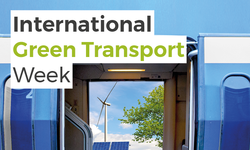
The International Green Transport Week has given us the opportunity to shout about how green trains really are. UIC kicked off the week with an article jointly penned with its partner, the International Union of Public Transport. The article conveys just how passionate we all are about the role of rail and public transport not only in decarbonising our economies but also in making our cities more liveable and mobility more accessible to greater numbers of people.
Read the article:
In a short animation, UIC, in partnership with Alstom, sets out a vision for rail travel in 2030. In the decade ahead, UIC and its members will undertake transformational projects; rail will be integral to this fourth industrial revolution and will embrace this new paradigm as a digital and renewable energy innovator. Train travel and logistics will be better connected and greener than ever and will transport more people and goods than ever before. UIC collates annual energy and emissions data from 70 passenger and freight railway companies and has seen sustained reductions in all measured emissions and a total reduction in energy consumption of 35% since 1990. The short videos shared on Wednesday and Thursday give some examples of how our members are already leading on decarbonisation and transforming their resource management processes from linear to circular.
This year’s EU Green Week topic of zero emissions has given us an opportunity to highlight our work in noise and vibration emissions. The Green Week also coincided with the biggest event in the United Nations Environment Programme – World Environment Day – on Saturday 5 June. This year the UN chose to focus on ecosystem restoration, which is wholeheartedly supported by UIC. The area around railway tracks is home to hundreds of rare animal and plant species, largely due to the lack of public access. Railways occupy, own and manage a large and diverse estate, and the way this land is managed can make a big difference to safe and reliable services, as well as the wildlife that lives on and near the land. Because of its linear, interconnected nature, rail-side habitats provide important corridors for wildlife, enabling movement of plants and species amongst often fragmented wildlife sites and making those sites more resilient. This habitat therefore represents an important biodiversity resource. A short video, shared on Friday 4 June, highlights two UIC projects on this topic: TRISTRAM and REVERSE.
The United Nations also recognises the role of public transport in halting biodiversity loss and has chosen to share this short video. Members are invited to use this UN message on digital media at stations and onboard trains.
In the lead-up to COP26 in November, UIC will work together with its partners and members to continue making the case for climate action with public transport.
UIC welcomes your support in spreading its message and conveying its collaborative efforts through your social media channels. Please do not hesitate to use the #InternationalGreenTransportWeek hashtag.
For more information, please visit our website: https://uic.org/events/international-green-transport-week
- Rail event – Train journey of the future:
- Rail event – Railways are becoming a better neighbour: a focus on noise and vibration:
- Rail event – Railways: leading the transition toward zero-carbon mobility:
- Rail event – Working towards a zero-waste railway: a focus on circular economy:
- Rail event – Railways connecting wildlife as well as people and goods: a focus on biodiversity:
For further information, please contact Lucie Anderton at anderton at uic.org
